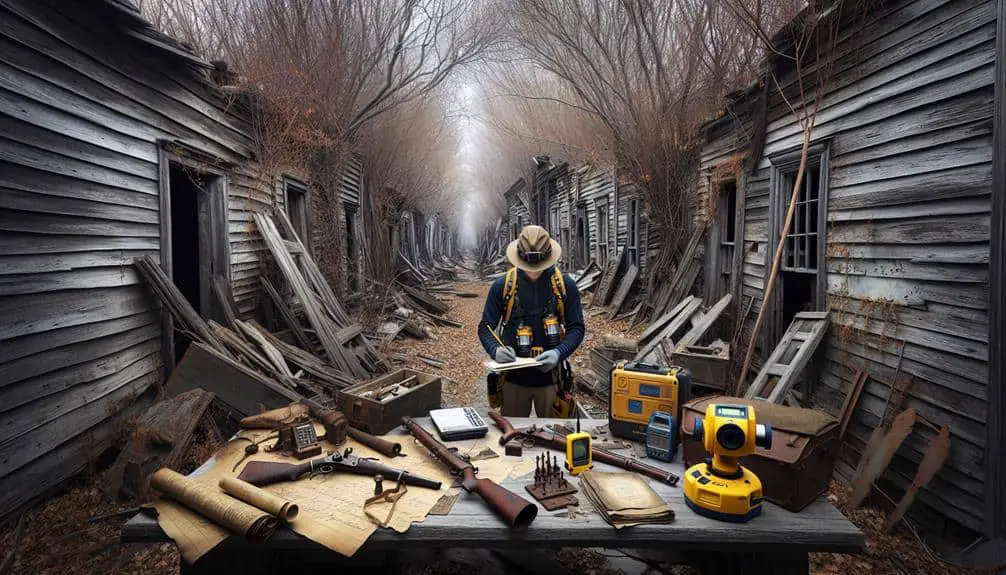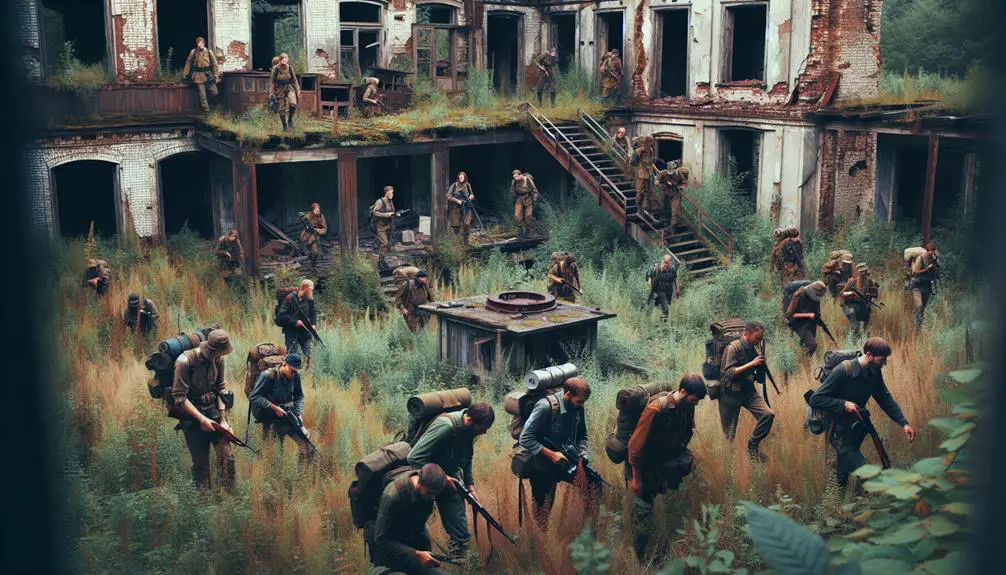Preserve US Civil War ghost towns effectively by conducting thorough historical research to uncover their stories and significance. Engage with local historical societies for insights and collaborate on preservation efforts. Document and map ruins using advanced techniques like photogrammetry and drone surveys to guarantee accurate preservation. Implement measures carefully to prevent deterioration and damage. Seek grants and establish partnerships with preservation organizations for restoration projects. Educate the public on the town's history through workshops and events. Monitor against vandalism through security cameras and community watch programs. Promote responsible tourism to respect wildlife and reduce waste. Ensure sustainable preservation by staying on designated paths and involving the community.
Key Points
- Conduct detailed historical research to uncover the stories and significance of Civil War ghost towns.
- Implement preservation measures using advanced techniques like photogrammetry and drone surveys.
- Seek grants and partnerships with preservation organizations for funding and expertise.
- Promote responsible tourism to ensure sustainable preservation and community involvement.
- Monitor and protect against vandalism through security measures and community watch programs.
Conduct Thorough Historical Research
To effectively preserve US Civil War ghost towns, conducting thorough historical research is essential. Archival research plays a critical role in uncovering the stories and significance behind these abandoned settlements. Delving into historical records, maps, photographs, and personal accounts can provide valuable insights into the town's past, its residents, and the events that led to its demise during the Civil War era.
Preservation techniques must be informed by this in-depth historical research to make sure that the ghost town's authenticity and historical integrity are maintained. By understanding the town's original layout, buildings, and cultural heritage, preservation efforts can be tailored to protect and conserve these valuable remnants of history. Utilizing the information gathered from archival research, experts can implement strategies such as stabilization of structures, artifact conservation, and landscape preservation to safeguard the ghost town for future generations.
Engage With Local Historical Societies
When looking to preserve US Civil War ghost towns, engaging with local historical societies is key. By collaborating with experts and attending community events, you can gain valuable insights into the town's history and ways to protect its heritage.
This active involvement helps foster a sense of community and shared responsibility for preserving these important historical sites.
Collaborate With Experts
Engaging with local historical societies can greatly enhance your understanding of the US Civil War ghost towns and aid in their preservation efforts. Expert collaboration plays an essential role in preserving these historic sites.
By working with specialists in archaeology, architecture, and conservation, you can access valuable knowledge and preservation techniques. Historical societies often have access to archives, documents, and artifacts that can provide insights into the history of the ghost towns.
Their expertise can guide you in implementing effective preservation strategies that align with best practices. Collaborating with these experts guarantees that the unique stories and structures of Civil War ghost towns are safeguarded for future generations to appreciate and learn from.
Attend Community Events
By actively participating in community events hosted by local historical societies, you can deepen your connection to US Civil War ghost towns and contribute to their preservation efforts.
Local festivals and cultural gatherings offer unique opportunities to engage with the history and heritage of these towns. Attending these events allows you to interact with experts, fellow history enthusiasts, and residents, fostering a sense of community and shared responsibility for conservation.
Through these interactions, you can learn firsthand about the challenges faced by these ghost towns and explore ways to support their preservation. By immersing yourself in these events, you not only enrich your understanding of the Civil War era but also play an active role in safeguarding these historical sites for future generations.
Document and Map the Ruins
When documenting the ruins of US Civil War ghost towns, it's essential to employ detailed methods that capture the historical essence of these sites accurately.
By utilizing advanced mapping techniques, you can create thorough visual representations of the ruins, aiding in their preservation and historical significance.
Ensuring the precision and thoroughness of your documentation will contribute to the long-term conservation efforts of these invaluable remnants of the past.
Ruins Documentation Methods
To accurately preserve US Civil War ghost towns, it's essential to meticulously document and map the ruins using advanced archaeological techniques. Utilizing photogrammetry techniques allows for the creation of detailed 3D models of the ruins by analyzing photographs taken from various angles.
Drone surveys are also invaluable in capturing aerial imagery to aid in mapping the entire site efficiently. These methods provide precise measurements and visual representations of the ruins, aiding in their preservation and future restoration efforts.
Mapping Techniques for Ruins
Mapping techniques for documenting and mapping ruins involve employing advanced archaeological methods to capture detailed 3D models and aerial imagery of the site. Utilizing drone mapping enables the collection of high-resolution images from various angles, aiding in reconstructing the layout of the ghost town.
LiDAR technology, which uses laser light to measure distances to the Earth's surface, can penetrate vegetation and provide precise elevation data, revealing hidden structures or features. By combining these cutting-edge technologies, researchers can create accurate maps that showcase the historical significance of the ruins.
This meticulous documentation not only preserves the heritage but also offers invaluable insights into the past, allowing future generations to appreciate and learn from the remnants of a bygone era.
Implement Preservation Measures Carefully
With what meticulous considerations should preservation measures be implemented when safeguarding US Civil War ghost towns? When handling the preservation of these historical sites, it's essential to proceed with caution and care to guarantee their longevity for future generations. Here are some key points to keep in mind:
- Handle with Care: Treat the structures and artifacts in the ghost towns with utmost delicacy to prevent further deterioration. Implement strict guidelines for visitors to follow to minimize damage.
- Preservation Partnerships: Collaborate with local historical societies, preservation experts, and community members to develop thorough preservation plans. By working together, a diverse range of perspectives and expertise can be brought to the table to ensure the best outcomes for the ghost towns.
- Regular Monitoring and Maintenance: Establish a routine schedule for monitoring the condition of the ghost town structures and implementing necessary maintenance. Regular upkeep can prevent irreversible damage and prolong the lifespan of these valuable historical sites.
Seek Grants for Restoration Projects
Consider exploring available grant opportunities to support the restoration projects of US Civil War ghost towns. Securing restoration funding through preservation grants can greatly aid in the upkeep and maintenance of these historically significant sites. Historical preservation is vital in maintaining the integrity and authenticity of these ghost towns, allowing future generations to learn from and appreciate the past.
When seeking restoration funding, it's essential to research and identify grant programs specifically tailored to historical preservation and restoration funding. Many organizations and government agencies offer grants aimed at supporting projects that focus on preserving historical sites like Civil War ghost towns. By taking the time to explore these opportunities, you can enhance the chances of receiving financial assistance for your restoration projects.
Applying for preservation grants requires attention to detail and a clear outline of how the funds will be utilized to restore and protect the ghost town's historical significance. Be diligent in following the guidelines set forth by the grant providers to improve your chances of securing the necessary funding for your restoration efforts.
Organize Community Clean-Up Events
Researching available volunteer opportunities for community clean-up events can be a proactive way to engage local residents in preserving US Civil War ghost towns. By organizing these events, you can foster a sense of community pride and involvement while helping to maintain these historical sites for future generations.
Here are three key tips to guarantee successful community clean-up events:
- Volunteer Recruitment: Utilize social media platforms, local newspapers, and community bulletin boards to spread the word about the clean-up event. Encourage volunteers of all ages and backgrounds to participate in this meaningful cause.
- Community Engagement: Engage with local schools, historical societies, and businesses to garner support for the clean-up events. Building strong relationships within the community can lead to increased participation and long-term preservation efforts.
- Event Planning: Plan the clean-up event carefully, considering factors such as the location, necessary supplies, safety precautions, and waste disposal. Creating a detailed schedule and assigning tasks can help guarantee a smooth and successful community clean-up event.
Establish Partnerships With Preservation Organizations
To enhance preservation efforts for US Civil War ghost towns, establishing partnerships with preservation organizations is crucial. Preservation partnerships offer a wealth of expertise in historical conservation, aiding in the maintenance of these valuable remnants of the past. By collaborating with such organizations, you gain access to funding opportunities that can greatly boost restoration projects, guaranteeing the long-term protection of these sites.
Through collaborative conservation and restoration efforts with preservation organizations, you can harness a broader range of resources, skills, and knowledge. These partnerships facilitate a more inclusive approach to preserving Civil War ghost towns, combining forces to tackle challenges and implement sustainable solutions. By working together, you can leverage each other's strengths to achieve common preservation goals effectively.
Building partnerships with preservation organizations not only strengthens preservation initiatives but also fosters a sense of community and shared responsibility for these historical treasures. This collaborative approach ensures that the legacy of US Civil War ghost towns endures for future generations to explore and appreciate.
Educate the Public on the Towns History
Partnering with preservation organizations not only secures funding for restoration projects but also plays an essential role in educating the public on the history of US Civil War ghost towns. Engaging residents in the historical education of these towns is vital to make sure their significance is understood and appreciated.
Here are three key ways to educate the public on the history of these ghost towns:
- Interactive Workshops: Host workshops where residents can participate in activities like artifact preservation, historical reenactments, or guided tours. This hands-on approach helps individuals connect with the town's past on a personal level.
- Educational Events: Organize lectures, presentations, or seminars by historians and experts to share in-depth knowledge about the town's history, key figures, and events that shaped its destiny. These events can attract a diverse audience who are keen to learn.
- Digital Platforms: Utilize websites, social media, and virtual tours to reach a wider audience beyond the town's physical location. By sharing historical content online, you can engage people who may not have the opportunity to visit the ghost town in person.
Monitor and Protect Against Vandalism
To safeguard the historical integrity of US Civil War ghost towns, implementing security camera systems can help deter vandalism and protect these valuable sites.
Additionally, establishing a community watch program can further enhance surveillance efforts and prompt immediate action in case of any suspicious activity.
Security Camera Installation
How can security camera installation effectively monitor and protect against vandalism in US Civil War ghost towns? Utilizing surveillance technology is essential for the preservation of these historical sites. Here are some tips to enhance security:
- Strategic Placement: Install cameras in key areas to maximize coverage and deter potential vandals.
- High-Resolution Cameras: Use high-quality cameras for clear footage that can aid in identifying perpetrators.
- Remote Monitoring: Implement a system that allows for real-time monitoring from a central location, enabling prompt responses to any suspicious activity.
Community Watch Program
Implementing a Community Watch Program can greatly enhance the monitoring and protection efforts against vandalism in US Civil War ghost towns. By organizing neighborhood patrols, community members can actively deter and report suspicious activities, contributing to crime prevention in these historical areas.
Establishing a visible presence through regular patrols can serve as a powerful deterrent to potential vandals. Encouraging community involvement fosters a sense of ownership and responsibility for the preservation of these valuable sites.
Training volunteers in effective communication and observation skills can further optimize the program's effectiveness. Utilizing a network of vigilant citizens can notably increase the chances of detecting and preventing vandalism before it causes irreparable damage to the ghost town's historical significance.
Promote Responsible Tourism Efforts
Encouraging visitors to engage in environmentally conscious practices while exploring these historic sites is crucial for sustaining the integrity of US Civil War ghost towns. To promote responsible tourism efforts and guarantee sustainable preservation, consider the following tips:
- Respect Wildlife: Keep a safe distance from any wildlife you may encounter during your visit. Avoid feeding animals and honor their natural habitat to preserve the ecosystem's balance.
- Reduce Waste: Carry a reusable water bottle and snacks in eco-friendly containers to minimize single-use plastics. Properly dispose of any trash in designated bins or take it with you to maintain the cleanliness of the ghost town.
- Stay on Designated Paths: Help protect the fragile structures and landscapes by staying on marked trails. Avoid straying off-trail to prevent unnecessary damage to the historical sites and surrounding environment.
Frequently Asked Questions
How Can I Determine if a Ghost Town Is Worth Preserving?
To determine if a ghost town is worth preserving, consider its historical significance and potential economic impact. Assess the town's unique story and tourism potential. Look at factors like preservation costs versus benefits to the community and future generations.
Are There Any Legal Issues to Consider When Restoring a Ghost Town?
Traversing the legal landscape when restoring a ghost town is akin to journeying through a labyrinth. Property rights, zoning laws, and historical preservation regulations are pivotal considerations. Ensuring compliance with all legal requirements is paramount.
How Can I Involve the Local Community in Preservation Efforts?
To involve the local community in preservation efforts, focus on community engagement. Organize events, workshops, and meetings to raise awareness. Use social media to attract volunteers. Collaborate with schools and local organizations for volunteer recruitment.
What Are Some Common Preservation Mistakes to Avoid?
When preserving historical sites, you must navigate common pitfalls like lack of funding, improper maintenance, and inadequate documentation. Preservation challenges include balancing modern needs with historical integrity and ensuring community engagement for sustainable conservation efforts.
How Can I Ensure the Safety of Visitors to a Preserved Ghost Town?
To guarantee visitor safety in preserved ghost towns, consider implementing proper signage, regular maintenance, and guided tours. These preservation techniques not only safeguard guests but also enhance the historical experience, making visits memorable and secure.



